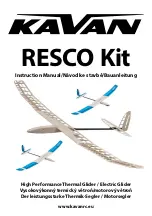
17
INFORMATION ABOUT DANGER
If the pilot makes mistakes while flying or there are extreme wind conditions or
turbulences which the pilot does not asses correctly, the glider can react
abnormally. These situations require special reactions and skills of the pilot.
The best way to stay calm and make the right decisions in such an emergency is
to do a safety training. You would be practicing with professional help on how to
handle extreme flight situations. Another good method is to get confident with the
reactions of the glider on the ground. You can practice the launch as well as small
manoeuvers like stall, front stall, one side fold up…etc. Every pilot who flies in
turbulences and makes mistakes with steering puts himself in danger of an
extreme flight situation.
WARNING
: All extreme flight and aerobatics are dangerous if the pilot does
not have enough adequate knowledge or enough safety height. Please stay in all
operating limits. Avoid aerobatics and extreme stresses. Like that you avoid
accidents and too much stress on the glider fabric.
Always keep enough distance to cliffs and other barriers during
turbulences. You need enough height and time for recovery in extreme
situations. If no recovery technics help or the height is too low, release the rescue
system.
SAFETY PRACTICE
Basically it is recommended to join a safety practice in order for you to know how
to react in extreme situations and get confident with your device. Nevertheless it
is always a high stress for the material if you practice these situations.
STRESS FOR MATERIAL AND DAMAGES
Uncontrolled flight situations – like they can be encountered during safety training,
extreme manoeuvres or after massive collapses or cascades - are outside the
manufacturer’s limits of the paramotor glider. This may cause a general
deterioration in flight characteristics, premature ageing, or even structural failure.
AREA OF APPLICATION
The APAX was developed and tested only to operate as a glider for foot launch
with or without an engine. Using it out of the area of application is illegal.
Never use it for skydiving. Aerobatics are illegal.
WINCHING
The APAX is adapted for winching using standard winching procedures. You are
responsible to ensure that your winching operations are safe and in compliance
with the applicable procedures. Make sure to have adequate training - suitable for
















































